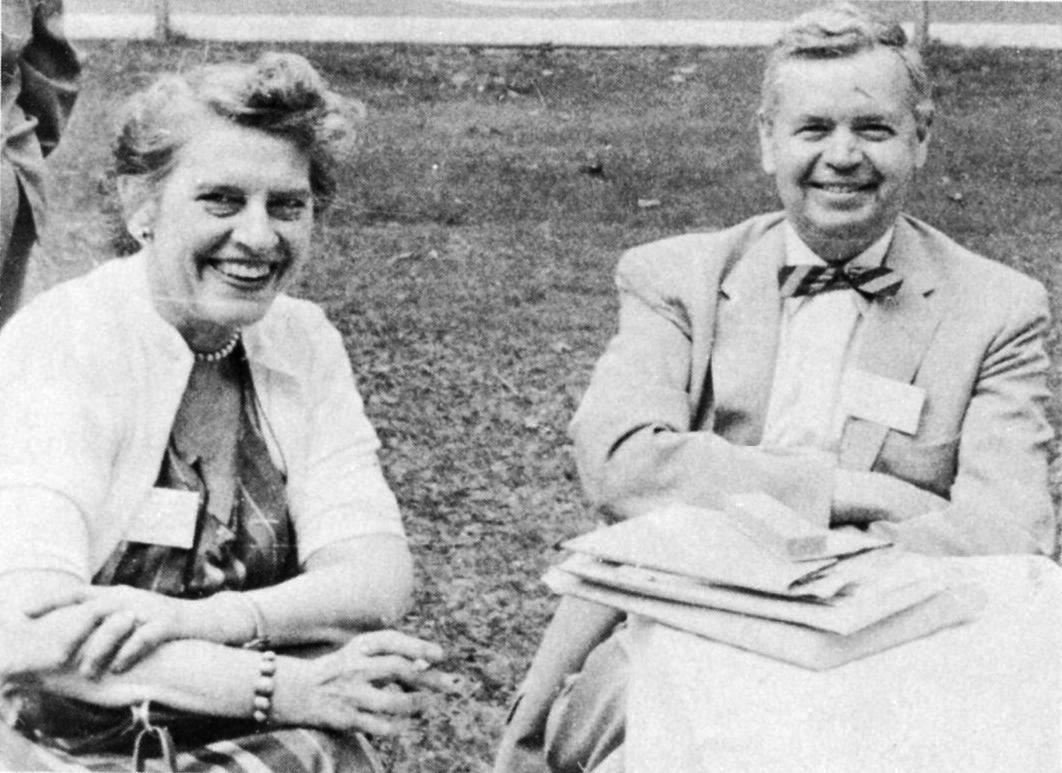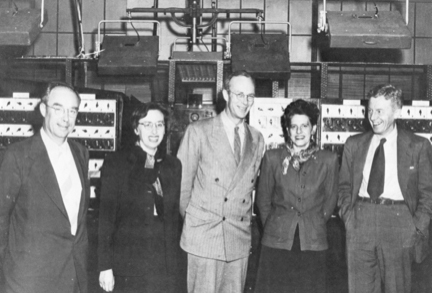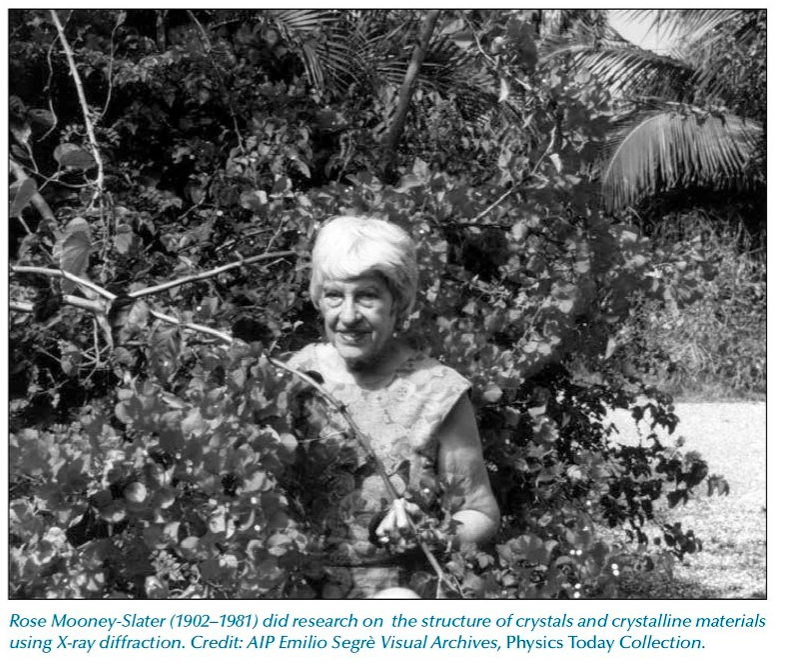- History Home
- People, Leadership & Service
- A Legacy of Excellence
- History & Impact
- Meetings Through the Years
- Resources
Articles - Rose C. L. Mooney-SlaterBiography | Publications | Curriculum Vitae | Videos | Slides | Articles | Obituary
Rose C. L. Mooney-Slater
By Frank Fronczek 2017
"Thank you, R. C. L. Mooney." So ends Richard E. Marsh's ACA Living History memoir, for it was she who introduced him to crystallography in 1945, launching him on his 70-year distinguished career. At the time of their meeting, she was a 42-year old professor of physics at H. Sophie Newcomb Memorial College, the sister school (coordinate women's college) of Tulane University in New Orleans. She was a Fellow in the American Physical Society, a Guggenheim Fellow, had served as Associate Director of the X-ray Structure Section of the Metallurgical Laboratory in the Manhattan Project, and had a distinguished publication record on the structures of inorganic compounds, complex ions formed by halogens and of synthetic fibers. She was the first female X-ray crystallographer in the United States, beginning her career shortly before Elizabeth Wood (1912-2006), and among the first in the world, being a contemporary of Kathleen Lonsdale (1903-1971), Dorothy Crowfoot Hodgkin (1910-1994) and Helen Megaw (1907-2002). She would go on to play a pivotal role in establishing a long tradition of X-ray crystallography at NBS/NIST, marry the noted physicist John C. Slater, and work as a research physicist at MIT and a research professor of chemistry at the University of Florida. She was an excellent teacher, well liked by students. Given that she was a pioneering female crystallographer and was influential in so many ways, it is remarkable that she is not better known today.
Early Life
Rose Camille LeDieu was born October 23, 1902 in New Orleans, to parents who were both Louisiana natives. At about age 20, she married a New Orleans pharmacist and WWI veteran eight years her senior, Carroll E. Mooney (1894-1965). She thus became R. C. L. Mooney, the name that she used on all her published work until 1961, when Slater was added. This marriage appears to have lasted at least eight years, perhaps quite a bit longer, but it seems unlikely that he accompanied her when she left New Orleans for graduate school.
Education
Rose studied physics as an undergraduate at Sophie Newcomb College, earning a B.S. in 1926. She remained at Newcomb as an instructor of physics until 1930, while working on her M.S. in physics at Tulane, a degree she earned in 1929. She then applied to graduate school at Caltech as R. C. L. Mooney. Dick Marsh best tells what then transpired: "Mooney had ... been accepted into graduate school at Caltech (my undergraduate school). But when Mooney arrived at Caltech, both sides were surprised: Caltech, because Mooney was a female (the "R" turned out to be "Rose"); and Mooney, because she did not know that Caltech, at that time, did not accept female students. What to do? My understanding is that Linus Pauling gave her a temporary appointment as research associate and helped arrange for her to transfer to the University of Chicago as a student of Will Zachariasen. She received her PhD there." (Note: Caltech's first PhD awarded to a female was in 1955, and undergraduate women were first admitted in 1970.) W. H. Zachariasen was four years younger than R. C. L. Mooney and just beginning his 44-year career at Chicago at age 24, but had been publishing excellent crystallographic work since he was 19. They had access to both Laue and oscillation cameras, and in 1931 she published the structure of potassium permanganate as sole author. In December of that year, she attended the New Orleans meeting of the American Physical Society and presented the structure of ammonium bicarbonate. The location of that meeting in her hometown was fortuitous for her, as funds for travel and particularly lodging were in short supply during the Great Depression, and she likely still had family, including a husband there. She would complete her PhD in physics the following year and return to Newcomb as an assistant professor of physics.
Career at Sophie Newcomb
Rose Mooney in about 1938.
Rose Mooney was a faculty member at Newcomb for 20 years, becoming associate professor in 1935, then professor and head of the physics department in 1941. Newcomb College was primarily an institution for the education of women, and Prof. Mooney was by all accounts an excellent teacher. Carrying out crystallographic research there was somewhat more problematic. Dick Marsh recalled that her "...office-laboratory-classroom contained a single X-ray tube and a Laue film holder - period" as late as 1945. However, she was quite adept at arranging to spend summers visiting institutions with better instrumentation and managing to do excellent crystallography. She did so at Johns Hopkins University, Caltech and the University of Michigan during the period 1934-38, publishing nine papers, most on structures of triiodide salts and those of related interhalogen anions. She was recognized by Linus Pauling for making significant progress in understanding the bonding in these ions, and in 1938, she was elected Fellow of the American Physical Society at the age of 36. Mooney would continue spending summers at other institutions, including Argonne and Oak Ridge National Laboratories, Polaroid, DuPont and the Massachusetts Institute of Technology (MIT). Besides giving Dick Marsh his start in crystallography, while at Newcomb, Mooney was mentor to Ruth R. Benerito (1916-2013), a noted chemist and inventor who spent most of her career at the USDA Southern Regional Research Center in New Orleans, where she invented wrinkle-free cotton fabrics. In an oral history, Benerito spoke warmly of Mooney, "I earned my masters in Science and Physics from Tulane University. And it was because of Rose Mooney, who later became Rose Mooney Slater who taught me after school, and I earned my degree in 1938 in physics and X-ray crystallography. . . . She was in physics and I understand she had something to do with the beginnings of the atomic bomb? . . . Well I graduated on '35 and I came back to teach high school, she taught me the evening after school and I got my degree in '38. Then in '41 she went to the University of Chicago, she had graduated from there. . . . So that was an exciting time to be at the University of Chicago during the war years. And she was there when I was there."
Guggenheim Fellowship
In 1939, R. C. L. Mooney was awarded a Guggenheim Fellowship with chemistry as the field of study, for "researches into the structure of crystals, in particular by methods of X-ray analysis". The tenure of the award was for twelve months beginning September 1, 1939. Apparently, her intent was to study in Holland, but events in Europe were deteriorating as WWII approached. She had been in that country during the month the fellowship period began, but returned to the U.S. from Rotterdam, arriving on September 29, the same month that Germany invaded Poland. Germany invaded The Netherlands on 10-May-1940, and the country surrendered five days later. Mooney's obituary in Physics Today states that she spent a year in Leiden, however it appears that she had to abort her studies very soon after they began on account of the war. She apparently carried out her studies at MIT instead, as the MIT President's Report for 1939-40 states "The X-ray branch had as a guest Professor Rose C. L. Mooney of Newcomb College, who was prevented by the war from carrying on research in Europe under a Guggenheim Fellowship." During this visit, the chairman of the Department of Physics was John C. Slater (see later).
Manhattan Project
When the U.S. entered WWII in December of 1941, preliminary research was already underway into the nuclear physics of uranium and the recently-discovered (May 1940) element plutonium. In 1945, this work would ultimately result in the plutonium implosion bombs exploded at the Trinity Site and over Nagasaki as well as the U235 atomic bomb used at Hiroshima. Only a month after Pearl Harbor was bombed, the Metallurgical Laboratory (Met Lab) was created at the University of Chicago, with emphasis on preparation of plutonium from uranium in nuclear piles, its purification, and understanding the chemistry of plutonium and other transuranium elements. The Met Lab was the precursor of Argonne National Laboratory. A number of scientists who would later become prominent crystallographers were involved in the Manhattan Project. Both Isabella and Jerome Karle worked as chemists in the Met Lab on the rather complex chemistry of plutonium. Joan R. Clark was a math assistant for the Manhattan Project in 1943, before she became involved in crystallography. There were likely others. A major problem with studying Pu metal was that it existed in six allotropes, and its chemistry was also difficult to study because only microgram quantities were available early in the project. William H. Zachariasen (1906-1979) was renowned for performing "X-ray miracles" in interpreting powder diffraction patterns from extremely small samples. He joined the Met Lab to establish an X-ray crystallography laboratory to study the crystal chemistry of transuranium compounds, and it is unsurprising that he chose his former student Rose Mooney to assist him. She took a leave of absence from Newcomb 1943-44 to become Associate Chief of the Met Lab's Structure Section, thus becoming one of the highest-ranking women in the Manhattan Project. Henrietta Anne Plettinger (1917-2012), who was a 1939 graduate of Sophie Newcomb, also came to the Met Lab and became an assistant to Will Zachariasen in 1943. She was also instrumental in the Structure Section, taking many if not all of the powder diffraction images for him. Plettinger would later spend 30 years at Argonne, become a renowned photographer, coauthor nine papers with Zachariasen and become an environmental activist after retirement to her native south Louisiana.
William Zachariasen, Rose Mooney, and H. Anne Plettinger.
It is not entirely clear to what extent Mooney and Zachariasen worked together in the Met Lab. The work at the time was of course top secret, and did not begin to see the light of publication until about 1948, after it was declassified. The two clearly collaborated on a very important study of the crystal structures of the oxides of plutonium. However, during 1948 and 1949, as sole author, Mooney published papers in the new journal Acta Crystallographica on the structures of ThCl4 and UCl4, "element 43" (technetium), and lanthanide phosphates. H. Anne Plettinger took the diffraction photographs for the actinide tetrachloride paper. The bismuth phosphate process, patented by Glen Seaborg, was used for separation of all the plutonium used in the Nagasaki bomb from other materials from the nuclear reactors. Mooney determined the structures of three polymorphs of bismuth phosphate as well as other bismuth compounds.
Mooney's marital status at this time is uncertain. In their book on women in the Manhattan Project, Their Day in the Sun, Howes and Herzenberg point out that there were very few female physicists at the time, and if married, they were "generally treated as talented amateurs." They incorrectly state that Mooney "married only after establishing her reputation as a crystallographer." It may not have been well known at the time that she was (or had been) married. From his WWII draft registration document, it appears that she was still married to her first husband as late as 1942. Carroll Mooney remarried in 1946, so they were certainly divorced by then.
By late 1944, the exploratory work of the Met Lab was essentially complete and the project shifted to the plutonium production phase. Rose Mooney returned as head of the Physics Department to Newcomb, where she would remain for another eight years.
National Bureau of Standards
In 1952, Rose Mooney left Newcomb College for a position as a senior physicist at the National Bureau of Standards (now National Institute of Standards and Technology), where she worked for four years with Howard F. McMurdie (1905-2004). The following year, he established the highly productive ICDD Research Associateship. NIST maintains no records about Mooney's activities at NBS, but Alan Mighell recalls McMurdie's comments that "...she was well liked, highly respected and that she played a pivotal role in establishing a long tradition of crystallography at NBS/NIST." From her Acta Cryst. publications during this period, it is clear that she continued her work begun during the Manhattan Project on structures of phosphate compounds, including phosphates of scandium, indium, thallium, aluminum, and gallium. In 1954, midway through her tenure at NBS, she married John Clarke Slater of the Department of Physics at MIT, whom she had likely met during her summer work away from Newcomb early in the WWII years. Jenny Glusker recalls, "I do remember that John Slater came to crystallographic meetings for a while and we all said it was because he liked to see Rose." It was the second marriage for both, and both were in their mid-50s.
R. C. L. Mooney-Slater and John Slater.
Massachusetts Institute of Technology
In 1956, Rose Mooney-Slater left NBS to join her husband as a research physicist at MIT, where she would spend the next ten years. Her research there continued along similar themes to those in previous positions, particularly structures of phosphates. She published her Manhattan Project work on bismuth phosphate polymorphs while at MIT, as well as further work on gallium, indium and thallium phosphates and the structure of tetragonal uranium disulfide.
A glimpse into Mooney-Slater's MIT years, albeit not a terribly complimentary one, was provided in an AIP oral history by Elsa M. Garmire, who was a graduate student in physics at MIT in the early 1960s. Garmire was briefly assigned to Mooney-Slater's lab because she was "the one woman on the faculty." Later to become an accomplished laser expert, fellow in both the APS and Optical Society of America, she was not cut out for Mooney-Slater's brand of inorganic crystallography, and would have found Watson and Crick DNA-related work or study of phase transitions more interesting. Garmire was distressed because Rose "didn't do any physics" and read only Acta Crystallographica. Interestingly, she was also under the impression that "she had never been married" before Slater.
In several of her publications from this era, Mooney-Slater acknowledges Raymond Pepinsky at Penn State for the use of his X-RAC analog computer for computing structure factors and Fourier maps. This revolutionary device, which displayed contours on a cathode ray tube and sped up crystallographic computations enormously was built in Auburn, Alabama and later moved to Penn State. Rose Mooney had been present at the dedication of this invention in 1949, along with a number of other notable crystallographers.
Dedication of the Pepinsky X-RAC Synthesizer, Alabama Polytechnic Institute,
ACA and other Organizations
Rose Mooney was very active in the ACA and IUCr from the beginnings of those organizations. When the American Society for X-ray and Electron Diffraction (ASXRED) and the Crystallographic Society of America (CSA) merged at the beginning of 1950 to become the American Crystallographic Association, she was appointed as a member of the Data Standing Committee. She was present at the first congress of the IUCr (Harvard, 1948) and published two papers in volume 1 of Acta Cryst. She was also one of the original members of the USNCCr in 1951. Mooney was a charter member of the Southeastern Section of the American Physical Society and served in many capacities in that organization while at Newcomb, including chairman (1946-47). Jenny Glusker recalls "She was a delightful lady and whenever she went to a crystallographic meeting and found herself among students and others that she did not know, she would introduce herself by name and invite people to come and talk to her. She was greatly admired for her careful work. I was just a postdoc at the time but I will always remember her with admiration."
Florida
In 1965, when John Slater reached the retirement age of 65 at MIT, the Slaters moved to the University of Florida, where the retirement age was 70, he in the Physics Department as a Research Professor in the Quantum Theory Project and she as a research professor in the Department of Chemistry. Both spent the remainder of their lives there. She taught physics but published no further crystallography, being in the twilight of her career just as automated diffractometers were beginning to become available. Rose retired in 1974, John Slater died in 1976, and Rose died on 21 November 1981 at the age of 79. They are buried together in Evergreen Cemetery in Gainesville.
Further Material
Both John and Rose Mooney Slater were among the 235 signatories of the congratulatory scroll presented to Max von Laue on the occasion of his 80th birthday, at the Cornell ACA meeting, July 1959.
Mooney-Slater bequeathed her husband's papers to the American Philosophical Society after his death, and the Slater estate also bequeathed a collection of her diaries and letters after her death. These include letters between the two before their marriage, her correspondence with H. Anne Plettinger between 1944 and 1976, and correspondence with Ray Pepinsky, Will Zachariasen and others. These documents are located at the American Philosophical Society Library, 105 South Fifth St., Philadelphia, PA 19106, USA.
Acknowledgements
Thanks to Jenny Glusker, Alan Mighell and Bill Fronczek for their assistance. |





